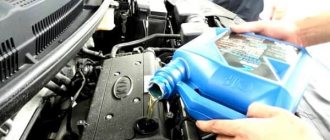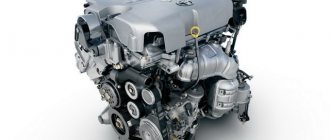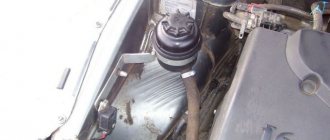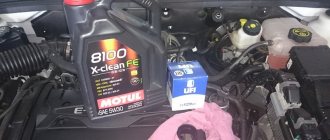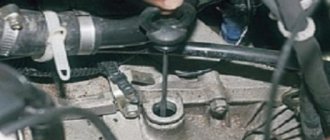Liquids for the unit in question: what are the features
Fluid for a diesel engine equipped with a turbine has a slightly different additive composition. Fuel combustion does not occur completely, so it requires a larger amount of additives that resist the oxidation process (and diesel fuel contains a large amount of sulfur, so the oxidation process needs to be more actively reduced).
The materials market today is at the peak of its development, so it becomes possible to create new types of lubricants of high quality.
Element designations
There are several designations for diesel and gasoline turbo engine types. Viscosity is indicated by using the SAE index, followed by the quality of the oil. For example, it may be characterized by the set of letters SF/SS. Let's look at what they mean below:
- S - indicates the possibility of using oil for gasoline power units with turbo.
- C is the second letter indicating the possibility of using fluid for diesel engines.
The dividing fraction following these indicators reflects the nature of the liquid in terms of versatility, that is, it can be used for different types of engines. The following letters characterize the level and properties of use, that is, they are responsible for the quality class of the elements. The higher the level of requirements for technical fluids, the further they go in the Latin alphabet.
Considering diesel units, it can be noted that there is a certain classification for them:
- CC - indicates the presence of components for supercharged engines; consumables can perform excellent work even in unusual conditions.
- CD are letters indicating high boost, as well as the possibility of operation in a special environment and with a content of sulfur exceeding the norm.
- CE - a high level of boost for engines produced after 1983, while the products can also be used for any type and nature of the engine in any external conditions.
- CF-4 - indicates the possibility of use on engines after 1990.
- GG-4 - can be used on engines after 1994.
All parameters are important and require a special approach to operation.
ACEA classification
In addition to classification qualities according to the API parameter, lubricant for turbocharged engines may have other varieties according to certain parameters, for example, according to ACEA. For diesel cars the classification is as follows:
- B1-96 - motor lubricants are traditionally used for passenger cars without turbochargers.
- B2-96 - used for turbocharged passenger cars.
- B3-96 - primarily motor fluids are used for luxury passenger cars.
- E1-96 - indicates that the lubricant can be used for trucks with a turbine.
- E2-96 indicates, in principle, the same parameters and characteristics, but they operate in an improved mode.
- E3-96 - used for trucks with higher supercharging.
Which one is more suitable is decided by the car owner.
Motor oil for a diesel engine: characteristics, differences from gasoline units.
Diesel is a less environmentally friendly type of fuel compared to gasoline. It is more difficult to burn completely and leaves behind much more soot.
Therefore, special requirements are imposed on lubricants created for it. Special additives are almost always added to them, which protect the engine from premature wear and destruction.
- The basis. According to this criterion, synthetics, semi-synthetics and mineral substances are distinguished;
- Motor design. For example, a distinction is made between motor oil for a diesel engine with a turbine or an atmospheric diesel unit;
- Compliance with international standards by which modern motor oils for diesel engines are classified depending on the intended use, including viscosity level - more viscous diesel motor oil is used in the warm season. Accordingly, a more liquid one is preferable for use in winter, at low temperatures;
- Intended use: in cars or trucks.
Class and viscosity indicators
In diesel and gasoline passenger engines without turbocharging, motor oils of class CD, B1 or even higher must be used, and in cars that were produced after 1990, motor oils of class CE, B2 or higher must be used. Such relatively stringent requirements are imposed due to the existence of increased loads, and also act as a guarantee of the long-term service of any vehicle.
The viscosity indicator also plays an important role when choosing; everyone knows that this parameter indicates a seasonal component. Products intended for use in summer have a higher viscosity, for example, this number can be 30. Motor oils intended for use in all seasons have a set of properties inherent in summer and winter products, since they contain special dampening additives. But this does not indicate the exceptional advantages of all-season oils, in particular for diesel engines. For example, a lubricant viscosity of 10W30 will help start the engine even during a cold start. As for modern units, the class is considered insufficient. There is a certain guideline that suggests taking this parameter into account in specific moments. All that remains is to decide which oil is best for a particular car engine.
Which one can be used
Not any two-stroke oil is suitable, it can make the engine even worse, so let’s figure out how to avoid ruining your engine without overpaying, and which one you can use. Two-stroke lubricants of category FB according to the JASO category, or category TV according to the API system, or a lower category.
These cheap two-stroke lubricants are not suitable for diesel engines, especially with soot filters. FB or TB level lubricants have a high ash content, so inevitable deposits will occur on injector nozzles, pistons, valves and other parts.
You should also not buy lubricants for outboard motors, as they are expensive, but in terms of lubricating properties they are no better than those described above. The cost of such lubricants is due to their ability to biodegrade, which is useful for the ecology of water bodies, since it does not create pollution, but is not useful for a diesel engine.
The optimal lubricants would be FC category according to the JASO classification, or TC in the API category. The most common suitable lubricants are TC-W. You can confidently add such a lubricant to diesel fuel. When choosing between cheap low-level oil or expensive boat oil, the best option would be to avoid adding oil to the fuel altogether.
Mineral or synthetic: what to choose?
The above indicators describe the quality class of a particular oil as best as possible, while the oil base is not always a priority. The main requirement is to respect the influence of price on quality and vice versa. Operating a car running on mineral oil will cost more. As for the synthetic product, it guarantees reliability and practicality of use. Synthetics have managed to perform better in low temperature conditions, but this does not mean that it is necessary to use only synthetic oil. If the mineral technical fluid fully complies with the requirements and parameters, then it can be used in a gasoline engine.
The issue of choosing a manufacturer is difficult for every driver; often this moment is accompanied by doubts even among a mechanic. The fact is that quite recently Soviet people did not have such a choice; there were only two types of liquids that did not raise questions. But the modern market offers so many options that you can easily get lost among them. Having settled on one option, you should not change the brand, but always give preference to the same manufacturer.
List of the most popular oils
The following types of oils have proven themselves well in terms of price/quality ratio:
- API Class CJ-4. This modification appeared in 2006.
- Class CI - can be used in diesel units equipped with high-quality turbocharging. Well-known brands include Mannol.
- Class CH is used for high-speed units. These are KIXX and other brands.
- Class CG-4 should be filled for units with an optimal level of toxicity.
- Class CF-4 is current, for example, this is WOLF Motor Oil 133/30 and others.
Thus, motor oils for turbine units are offered in a wide variety. Which of them is optimal to fill for a particular motor is up to the user to decide.
Diesel oil change intervals
How often to change the oil in a diesel engine is another problematic question to which there is no clear answer. Automakers recommend making replacements at least after fifteen thousand kilometers traveled by the car with a synthetic emulsion class and at intervals of six thousand kilometers with a mineral-type lubricant. However, in practice, these figures do not always correspond to reality, and the frequency depends on numerous factors. The interval between required engine fluid changes is affected by:
- The age of the car. The older the car, the more pronounced the wear of structural parts is, which is reflected in the replacement interval towards a decrease.
- Intensity of transport operation. The more often the car is in working condition, the faster the oil becomes unusable.
- Driving style. In extreme vehicle operation and aggressive driving, the engine overheats more often, which affects the properties of lubricants, as well as the frequency of necessary oil changes.
- Qualitative characteristics of the fuel, on which the efficiency of the engine and the service life of the lubricant depend.
Accordingly, the preferred oil change interval in a diesel engine directly depends on the year of manufacture of the vehicle, its operating conditions, fuel quality and road surface. Based on this, experts call the average period between car oil changes four and ten thousand kilometers traveled for mineral and synthetic lubricants, respectively. Experienced car owners can sense from the “behavior” of the car the need for an unplanned change of emulsion due to unnatural sounds from the power unit and deterioration in the functional features of the car. If there is the slightest indication of a decrease in the quality of the engine oil, you should immediately start replacing it, without waiting for serious consequences in the form of failure of the power unit.
Features of operation
Some car enthusiasts, having barely discovered a slightly blackened fluid after 500 km of driving, begin to worry that the lubricant has deteriorated and rush to replace it. But this is not always the right decision: blackening does not mean anything bad and indicates that soot has formed in the liquid and the additives have begun to work more actively. There is another opinion: if you use high-quality synthetics, you can increase the service life. This is again a misconception, since the use of waste material is doubly harmful.


